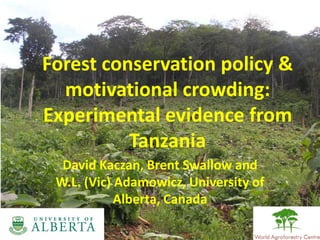
Session 3.6 forest conservation policy and motivational crowding
- 1. Forest conservation policy & motivational crowding: Experimental evidence from Tanzania David Kaczan, Brent Swallow and W.L. (Vic) Adamowicz, University of Alberta, Canada
- 2. East Usambara: Multiple Ecosystem Services from a multi-use landscape
- 3. East Usambara: Biodiversity Under Threat Reyes et al. (2007) • 60% of forest cover lost in East Usambaras • 26% of remaining forest has cardamom
- 4. Payments for Environmental Services and Motivational Crowding • Financial payments have potential to incent farmers to maintain or adopt land uses consistent with environmental services (water quality, biodiversity conservation and carbon storage) • Psychology has clarified two distinct motivations for behavior: extrinsic (reward or penalty) or intrinsic (enjoyment, interest or duty) (Frey and Jengen, 2001). (Israeli Day Care example) • Concerns that financial payments may “crowd out” intrinsic motivations and that crowding out may persist after payments stop (eg Farley and Constanza, 2010)
- 5. Research Methods • Field experiments move experimental economics from lab to field (Cardenas, Jack) • Field experiment with 250 men and women farmers from two villages in the East Usambaras • Modified “dictator game” to examine persistent motivational crowding of PES payments $10 endowment $2 transfer
- 6. Experimental design: dictator game 30 Tsh 50 Tsh 20 Tsh 40 Tsh 50 Tsh 20 Tsh Donated to passive group Treatment 1, 2: Receive compensation Treatment 3, 4: Regulation requires certain amount be donated
- 7. PES simulations , with private and collective compensation and high and low penalties
- 8. Results of Games (Difference in Differences Model – differences in generosity between pre-policy, policy and post policy, between policy treatments.) Standard Dictator Game: average donation 37% without payment or enforcement Private PES: average donation of 42%, about equal to reward, suggesting PES substituted for intrinsic motivation (crowding out) No evidence of persistent crowding out, when payments stopped, donations returned to average of 33% Collective PES: no effect of PES on donations during the policy period Regulation prompted an increase in payments greater than economically rational, (55% for high enforcement, 45% for low enforcement) implying a motivation to follow rules beyond expected $ value of fines themselves.
- 9. Differences in Crowding Behavior (Latent Class Model – exploring systematic differences in responses to extrinisic incentives) Class 1 (62% of sample) exhibited motivational crowding in –after being financially rewarded for donations, this group had post- policy donations 21% higher than pre-policy donations. Class 1 participants had smaller land sizes, were likely to be male and were likely to be born in the village. Class 2 (38% of sample) exhibited motivational crowding out – after being financially rewarded for donations, this group had post- policy donations 6% lower than pre-policy donations.
- 10. a •No evidence for persistent crowding out for rewards. •Evidence for persistnt crowding in for enforcements. • Fact of enforcement may be more important than its magnitude. •Collective payment unsuccessful. •Strong heterogeneity of preferences: some people crowded out, others crowded in (LCM) In summary . . . Acknowledgements: Funding – AAEA, ICRAF, U of Alberta Advice -- Heini Vihimalki, Salla Rantala, and Rene Bullock Field assistance -- F. Njilima, V. Mkongewa, Y. Mwaikio, A. Kajiru, J. Mzalia, Mr. Yambazi;
